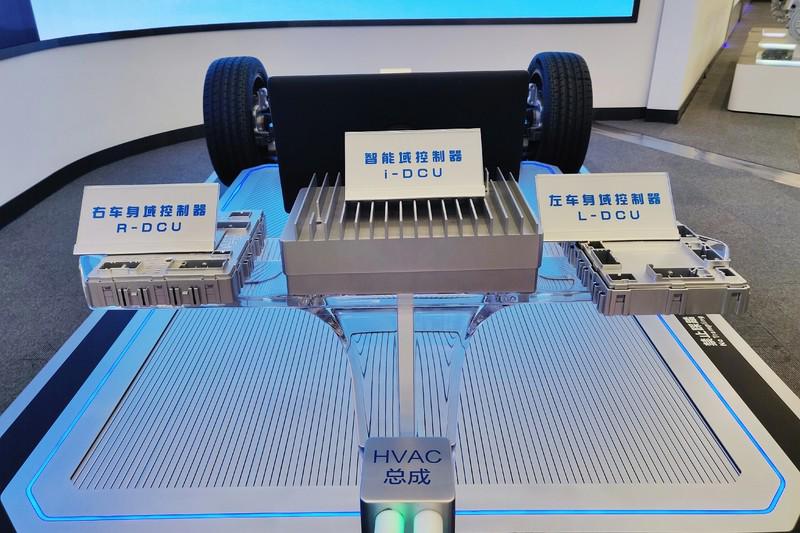BYD Atto3 and e-platform 3.0: Intelligent, Efficient, Safe
 Kevin WongFeb 23, 2024, 07:25 PM
Kevin WongFeb 23, 2024, 07:25 PM
The BYD Atto3 is already a global model, with a presence in regions such as Europe, Australia, and South America, including Thailand. In 2023, the Atto3 was the best-selling pure electric vehicle in Thailand, with sales approaching 20,000 units for the year.
However, many people may not be familiar with this car or BYD, the strong new energy vehicle brand from China. Technology is actually one of the key highlights of the Atto3, but what exactly is the e-platform 3.0 and technologies like blade batteries? What changes can it bring to practical use?
In this article, we'll discuss the technology related to BYD's e-platform 3.0. Although this platform was released in 2021, even today, BYD's main models are still based on the e-platform 3.0, whether they are sold in China or exported to overseas markets, such as the Atto3.
Here are a few points about the benefits of vehicle platformization that we need to know:
1. Cost reduction: Different models on the same platform can share many components, reducing component production costs and the selling price of the entire vehicle.
2. Stable quality: Parts sharing improves the stability of components' quality.
3. Shortened development cycle: This is an important advantage for automakers. The platform acts as a base model with a fixed structure and variable parts, allowing different models to be adjusted in the variable parts.
4. Improved vehicle dynamics: Platform development can ensure the vehicle's dynamic performance from the beginning, such as improving body rigidity for better handling or emphasizing comfort. An example of this is Toyota's TNGA architecture.
Regarding the e-platform 3.0, here are some key points:
1. e-platform 3.0 comes standard with blade batteries.
2. Integration of the body and battery.
3. A new domain-controlled electrical architecture.
4. Independently developed BYD OS operating system.
5. Innovative eight-in-one electric drive assembly, with a comprehensive efficiency exceeding 89%.
6. Wide-temperature, high-efficiency heat pump system, improving winter range by up to 20%.
7. 800V high-voltage fast charging, providing a range of 150km in 5 minutes.
8. Range exceeding 1000km, with the fastest acceleration of 2.9s per 100km.
BYD's e-platform 3.0 is officially touted for its intelligence, efficiency, and safety. Let's look at each aspect separately.
1. Intelligence:
Four major domain controllers
e-platform 3.0 fundamentally designs the vehicle's electrical architecture in a modular and centralized manner. The biggest highlight is integrating dozens of ECUs into four major domain controllers (left vehicle body domain controller, right vehicle body domain controller, intelligent domain controller, power domain controller).
In simple terms, it transforms from a single-function single-ECU to a multi-core CPU domain controller with stronger processing capabilities, and through CPU integration, the computing power of e-platform 3.0 has increased by 30%; through function integration, the interaction efficiency of controllers has increased by 50%, laying a solid foundation for powerful advanced driving assistance systems in the future.
Independently developed BYD OS vehicle system
This system is not as simple as modifying the Android system. Its main function is to decouple the hardware layer from the application layer, that is, the software and hardware are independent of each other, achieving a higher level of synergy and better utilization of the vehicle's advanced electrical architecture.
A self-developed vehicle system can more efficiently achieve high-level autonomous driving, greatly improving the iteration speed of new functions. Therefore, the iteration speed of new functions of e-platform 3.0 has become faster, from the current two-month iteration cycle to two weeks, reducing by more than 70%.
Lidar
In the field of intelligent driving, BYD will use lidar + cameras + millimeter-wave radar intelligent driving hardware, which means that the existing e-platform 3.0 will also have strong expansion capabilities in future intelligent functions.

2. Efficiency
Eight-in-one electric drive assembly
The three-in-one electric drive system composed of a drive motor, motor controller, and reducer is a technological highlight we often hear about in many new energy vehicles. In e-platform 2.0, BYD proposed an easy-to-understand "33111" concept, which means a three-in-one drive motor, a three-in-one high-voltage controller, a multiple-in-one low-voltage controller, one power battery, and one DiLink intelligent networked central control screen. Just the three-in-one drive motor and the three-in-one high-voltage controller can reduce the weight of the entire vehicle by 40% and save 37L of space.
In e-platform 3.0, BYD directly integrated an eight-in-one electric drive assembly, which includes the drive motor, motor controller, reducer, onboard charger, DC converter, distribution box, vehicle control unit, and battery manager.

Why make an eight-in-one electric drive assembly? Highly integrated electric drive assemblies can better achieve lightweight and miniaturization, not only reducing the space occupied by the electric drive assembly and freeing up more space for the cabin or suspension system but also achieving more efficient power transmission. This eight-in-one electric drive assembly has a comprehensive efficiency exceeding 89%, effectively reducing the loss of power transmission and bringing better economy.
In terms of parameters, the front-drive eight-in-one electric drive assembly of e-platform 3.0 has a peak power of 150kW and a peak torque of 310N·m; the rear-drive eight-in-one electric drive assembly has a peak power of 270kW and a peak torque of 360Nm.
High-performance silicon film-driven motor
The drive motor of e-platform 3.0 adopts a hairpin-style flat wire motor, with a 15% increase in slot filling rate and an optimized magnetic circuit design using ultra-thin high-performance silicon films. After operation, the rated power of the entire drive motor is increased by 40%, and the motor's maximum efficiency can reach 97.5%.

SiC electronic control
With a more efficient drive motor, it naturally needs to be matched with a higher-performance electronic control system. e-platform 3.0 uses a new generation of SiC electronic control. This electronic control system uses a self-developed 1200V/840A new SIC module (maximum voltage 1200V, maximum current 840A) and is equipped with high-performance silicon nitride ceramics and integrated NTC sensors. The entire electronic control system's power density is nearly tripled, and the electronic control's maximum efficiency reaches 99.7%.
Range of 150km in 5 minutes of charging
In e-platform 2.0, BYD used an independent boost charging device to increase the output voltage of the charging pile to achieve a stable fast charging mode. e-platform 3.0 adopts a new motor boost charging architecture, equipped with the world's first motor-driven boost charging technology, integrating driving and charging deeply to achieve 800V high-voltage fast charging.
Range exceeding 1000km?
BYD's future vehicles equipped with blade batteries (lithium iron phosphate batteries) will exceed 1000km in range.

In addition to using larger capacity battery packs, increasing range can also be achieved through improved drive efficiency, optimized electronic control system logic, lightweighting, and reducing aerodynamic drag. The drive system's efficiency has already been mentioned, so it won't be repeated here, but the new vehicles on e-platform 3.0 can achieve a minimum drag coefficient of 0.21Cd, which can naturally improve range.
Of course, increasing the energy density of the battery can also improve the range. Compared with ternary lithium batteries, lithium iron phosphate batteries have a lower battery energy density. BYD is expected to achieve a breakthrough in the energy density of lithium iron phosphate batteries to exceed 1000km in range.
3. Safety
Standard blade batteries
The new cars built on the e-platform 3.0 will all be equipped with blade batteries (lithium iron phosphate batteries), which is not really a highlight because as early as April 2021, BYD's electric vehicles had already been fully equipped with blade batteries. One of the highlights of blade batteries is safety. When BYD introduced blade batteries to the Chinese market, it conducted a series of comparative experiments on puncture of battery packs, which caused a heated topic in China and became one of the core technologies of BYD's models.

Integration of body and battery
Blade batteries themselves have a flat design, which is close to the body floor. Therefore, on the e-platform 3.0, BYD integrates blade batteries into the body, directly making the body and battery integrated, making the battery pack part of the body structure, thereby improving the overall strength of the vehicle.
Under the new platform, the body's torsional stiffness can reach 40,000Nm, which can effectively suppress chassis vibration, improve driving feel and handling performance, and greatly improve the vehicle's safety performance.
In addition, the body structure has been adjusted for pure electric vehicles, such as further reducing the height difference of the longitudinal beams, making the transfer of impact forces smoother during frontal collisions, and improving the dispersion and absorption of impact forces. The application of a full-frame subframe can also improve the body's strength and make the force transmission path more uniform.
Editor's comment
It should be noted that it has been more than two years since the e-platform 3.0 was released. Some technical parameters in this article may have changed with the improvement of component performance during this period, but its overall characteristics have not fundamentally changed.
BYD's new energy vehicles are not only selling well in China but also in the global new energy vehicle market, indicating that BYD has deep technological capabilities in the field of new energy vehicles. It is understood that when BYD was founded in the 1990s, it started with battery manufacturing and later expanded into various fields. Entering the automotive field was something that happened twenty years ago. But since then, BYD has been making new energy vehicles, which is also a unique feature of the BYD brand.
Today, BYD's models such as Atto3, Dolphin, and Seal are available for sale in China, but it is evident that Atto3 is more popular. How will BYD develop its presence in the Thai market in the future? We will wait and see!
If any infringement occurs, please contact us for deletion
Trending News

Perodua Traz VS Ativa, which one is more worth buying?
Traz, as a newly launched mid-sized SUV, offers more spacious room and mainstream power compared to small SUVs, but its pricing appears slightly higher than that of Ativa. Ativa, on the other hand, is Perodua's long-time best-selling small SUV with more affordable pricing and a balanced combination of power and tech features.

Perodua Myvi and Bezza may undergo major upgrades in 2026
After the update, the Bezza will no longer be just a low-cost alternative but a core model in the Perodua system with greater market competitiveness and brand premium potential. The upgrade of the Myvi is not to be unconventional but to strengthen the brand and market, ensuring that the Myvi continues to maintain its irreplaceable position in the new round of product competition.

Perodua Traz VS Toyota Yaris Cross, where does the Traz fall short?
Before the official launch of the Perodua Traz, market expectations were actually very high because it shares the same DNGA platform as the Toyota Yaris Cross. However, sharing the same platform does not equate to the same experience, and the Traz's final performance has indeed been disappointing. Perhaps it is precisely because of the delayed launch that it has almost no competitiveness in the current competitive environment.

Will the Toyota Yaris Cross come to Malaysia? If it comes, how much will it sell for?
The launch of Perodua Traz indicates that the market size of small SUVs in Malaysia has been expanding in recent years. However, the question naturally shifts back to Toyota. As a brand with the most comprehensive product line and a strong foundation in both the SUV and hybrid sectors, will Toyota choose the Yaris Cross to participate in this small SUV competition?

Why is the Toyota Sienna so popular with so many people?
In Malaysia, most family MPVs choose Toyota Alphard, Vellfire, or Kia Carnival. These models each have their advantages in luxury, space, or brand influence, but models that truly balance large space, multifunctional practicality, fuel efficiency, and reliability are rarely seen.
Popular Cars
Model Year
Car Compare
Car Photo



